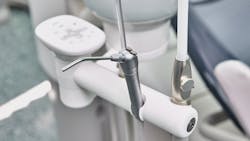Following waterline safety fails, CDC issues rare health advisory to dental community
On Oct. 31, the Centers for Disease Control and Prevention (CDC) issued a "very unusual" health advisory to the dental community following outbreaks of nontuberculous Mycobacteria (NTM) infections in children.
The Health Alert Network (HAN) Health Advisory was sent following a cluster of suspected NTM infections in March 2022 in children who received pulpotomies in pediatric dental clinics where the dental treatment water contained high levels of bacteria. According to the advisory, investigation into this cluster is ongoing, and preliminary site visit data report that dental unit waterline testing results showed microbial counts much higher than the level recommended by the CDC.
In addition to the March cluster outbreaks, in 2016 there was an outbreak at a pediatric dental clinic in Orange County, California, involving 71 patients identified as having NTM infections following procedures. Municipal water stored in a pressurized bladder holding tank was used to fill the dental unit water bottles; the clinic was not using disinfectants on their dental unit waterlines or regularly monitoring water quality.
Related reading
Dental unit waterlines: Trickier than you think
And in 2015, 24 cases of odontogenic NTM infections were reported in children who received pulpotomy treatment from a pediatric dental clinic in Georgia. Investigators from the Georgia Department of Public Health found that municipal water was used during dental procedures, the clinic was not using a disinfectant in their dental unit waterlines, and the clinic wasn’t regularly monitoring the water quality as recommended by CDC.
The outbreaks in California and Georgia involved children from 4 to 8 years old, many of whom developed severe infections, with clinical diagnoses such as cervical lymphadenitis and mandibular or maxillary osteomyelitis, and required hospitalization, treatments such as intravenous antibiotics, and surgical procedures. Complications from their infections included permanent tooth loss, hearing loss, facial nerve palsy, and incision fibrosis.
In its alert, the CDC reiterated its guidelines on treating dental unit waterlines and monitoring water quality to ensure that dental treatment water is safe for patient care. Its recommendations for dental providers include:
- For all oral surgical procedures, use sterile saline or sterile water as a coolant or irrigant for surgical procedures. Appropriate delivery devices can include bulb syringe, sterile, single-use disposable products, or sterile water delivery systems that bypass the dental unit by using sterile single-use disposable or sterilizable tubing.
- For all non-surgical dental procedures, use water that meets CDC recommendations (i.e., ≤500 CFU/mL of heterotrophic water bacteria). For all non-surgical pulpal therapy and endodontic procedures, consider following more conservative recommendations.
- Consult with the dental unit manufacturer for appropriate methods and equipment to maintain the quality of dental water. Many commercial devices and procedures are available and designed for this purpose.
- Follow recommendations for monitoring water quality provided by the manufacturer of the unit or waterline treatment product.
- Discharge water and air for a minimum of 20–30 seconds after each patient from any device connected to the dental water system that enters the patient’s mouth (e.g., handpieces, ultrasonic scalers, and air/water syringes).
- Review the US Food and Drug Administration’s (FDA) website on Dental Unit Waterlines for recommendations for dental practitioners.
In comments to DentistryIQ, Michelle Lee, executive director of the Organization for Safety, Asepsis and Prevention (OSAP), called the advisory "very unusual" and stressed the importance of routine waterline testing to assure patient safety.
"Bacteria occur naturally in all freshwater environments—including dental unit waterlines. Dental waterlines are especially susceptible to biofilm formation for a number of reasons" Lee said. "This CDC HAN Alert highlights the importance of properly treating and maintaining waterlines in the dental setting to comply with EPA recommendations for drinking water. And, unless dental personnel routinely TEST dental waterlines, they cannot be assured that their dental unit water is safe for patient care."
Access the full CDC Heath Alert Network alert, including references and specific recommendations for dental facilities, medical providers, health departments, and the public: Outbreaks of Nontuburculosis Myobacteria Infections Highlight Importance of Maintaining and Monitoring Dental Waterlines
Primarily sourced from CDC Health Alert Network; content edited for style and length

